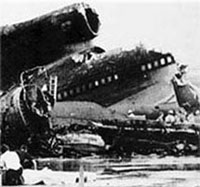I came across a disturbing article recently (where, I have no idea) that concerns past flights bearing the number 191. As it turns out, some of the most tragic non-terrorist airline accidents in the United States have occurred on flights numbered 191. As you know, the most recent commercial aviation disaster, Delta Flight 5191, was operated by Comair under the designation 191 (although passengers' tickets would have read 5191). 49 of the 50 passengers on board perished in the Lexington, KY, crash, the only survivor being First Officer James Polehinke, who happened to be flying the plane as it took off the wrong runway and crashed into a wooded area just beyond the airstrip.
 (above: This haunting photograph depicts American
(above: This haunting photograph depicts American
Airlines Flight 191 in its final moments before hitting
the ground. The missing #1 engine and steep roll are
clearly visible in the photograph.)
Perhaps the darkest day in domestic commercial aviation before September 11, 2001, occurred on May 25, 1979. At Chicago's bustling O'Hare International Airport, American Airlines Flight 191, an LAX-bound DC-10 carrying 258 passengers and 13 crew, crashed upon takeoff when the entire #1 engine separated from the left wing. While the engine fell away from the aircraft exactly as it was designed to do in such a scenario, the pilots lost complete control when hydraulic fluid began to leak from the left wing, causing the flaps to slowly retract. At such a low speed, the left wing failed to produce the required lift and aerodynamically stalled, while the right wing, undamaged during takeoff, continued to produce lift. This resulted in the aircraft rolling completely to the left, almost perpendicularly to the ground, finally causing the plane to crash at a nearby trailer park. All 271 people on board and two on the ground were killed. It was determined that during a previous repair, the #1 engine had been improperly reattached to the wing, causing the attachment surfaces to become weakened and unable to withstand the repeated application of force upon takeoffs and landings. The loss of life in the crash remains second only to that on board the two 767s that crashed into the World Trade Center Towers on September 11, 2001.
Just six years later, Delta Airlines Flight 191, a Lockheed L-1011 bound for LAX from Fort Lauderdale via Dallas-Fort Worth International Airport, crashed during a landing attempt at Dallas. The plane, carrying 152 passengers and 11 crew members, approached the airport amid thunderstorm activity. During its landing attempt, the aircraft began to speed up, which pilots determined was a sign of wind shear. When the aircraft suddenly slowed down, the crew lost control of the massive aircraft (which, interestingly, is a widebody, 3-engined design similar to the DC-10 that crashed 6 years earlier), and it crashed into the ground, only to bounce back into the air, cross a major highway, and impact the ground once again on top of a car. In additional to the car's occupant, 128 passengers and 8 crew members died. While the pilot was found to be at fault for the crash, its major cause was determined to be microburst-induced windshear.
 (Above: The eerie remains of Delta Airlines
(Above: The eerie remains of Delta Airlines
Flight 191, which crashed at Dallas - Fort
Worth in 1985.)
As is customary for the aviation industry, Delta Airlines and American Airlines retired the Flight 191 designation after their respective crashes, and there is also no longer a Comair 5191. Perhaps these horrific crashes, all numbered Flight 191, should encourage other airlines to discontinue this numbering on any of their flights. After all, there is a precedent for superstition in the airline industry - some airlines' planes, including those on Airtran's fleet, don't have a "row 13"...check that out the next time you're flying.
 The ~100-foot long Hood Blimp, famed for its appearance over New England sports events, crashed into the woods in the vicinity of Manchester-By-The-Sea in Massachusetts' North Shore today. The blimp, which usually hovers over games at Boston's Fenway Park, experienced mechanical failures with its rudder this morning. The pilot attempted a landing on nearby Singing Beach (a small strip of sand that serves as my beach of choice in MA) but ended up stranded in trees nearby. The crash was uneventful, as the craft apparently made a smooth landing into the trees, where it proceeded to deflate as the pilot communicated with rescue crew for over 2 hours about the nature of the crash before he was rescued.
The ~100-foot long Hood Blimp, famed for its appearance over New England sports events, crashed into the woods in the vicinity of Manchester-By-The-Sea in Massachusetts' North Shore today. The blimp, which usually hovers over games at Boston's Fenway Park, experienced mechanical failures with its rudder this morning. The pilot attempted a landing on nearby Singing Beach (a small strip of sand that serves as my beach of choice in MA) but ended up stranded in trees nearby. The crash was uneventful, as the craft apparently made a smooth landing into the trees, where it proceeded to deflate as the pilot communicated with rescue crew for over 2 hours about the nature of the crash before he was rescued.











